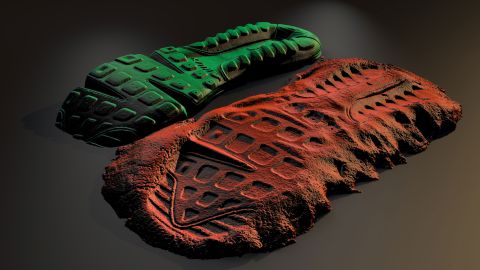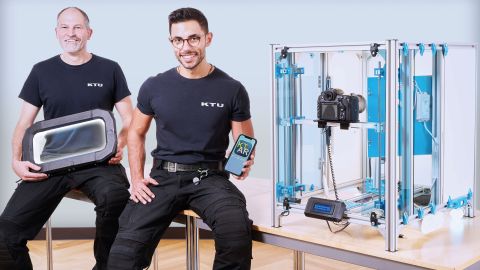What do Duckburg, the home of comics, and the state capital Düsseldorf have in common? Quite simply! Two very special inventors. What Daniel Gyro Gearloose is in Duckburg, Detective Superintendent Maikel Stiefel (32) is in Düsseldorf. The only difference is that Stiefel doesn't have "Helferlein" at his side, the little robot with a light bulb for a head, but his real-life colleague Detective Chief Superintendent Andreas Nick (46). They work side by side in the Forensic Investigation Unit (KTU).
The two inventors have already developed a number of things in the past, but now they have a ground-breaking invention: a new method for securing footwear impressions, contactless and three-dimensional, using photogrammetry. This is a process in which a 3D model is created slice by slice from a large number of overlapping images. That sounds simple. In fact, however, all attempts to digitize the process for forensic purposes have so far failed.
For decades, there has only been one method of securing footwear impressions in the soil at crime scenes. They are filled with mixed plaster. "Depending on the weather, the gypsum quickly takes on the wrong consistency or the soil is altered when it is poured in," Stiefel explains the particular challenges. Consequence: the shoe track is unusable.
So how did Stiefel come up with the idea of changing the method for shoe impression marks? It all began in 2020, when Stiefel was trained as an expert for shoe and tire marks at the NRW State Office for Training, Further Education and Personnel Affairs of the Police. Speaker Jochen Wirz reported on several attempts to replace the classic plaster method with 3D scans. However, the tested strip light projection scanner required time-consuming training, was expensive and, all in all, was not suitable for crime scene work. That's where the "seed was sown" at Stiefel. "There's no such thing as impossible", he thought to himself and started tinkering at home, sitting "in a quiet room" for nights on end. His approach: the photogrammetric method.
The first goal: to create 3D models of the suspects' comparative shoes in an automated process that could be used in court. "It was important to me that the application was very simple for my colleagues. At the touch of a button," Stiefel recalls. The result was a cube in which a shoe is fixed in the middle. This is captured by photogrammetry using a high-resolution SLR camera. The images in this "KT-ScanCube" ensure the automated digitization of shoes in 3D.
Further ideas and development steps were necessary to bring the system to final series production readiness for the preservation of evidence. During the entire development process, Stiefel discussed his ideas and prototypes with his colleague Nick in the office. Nick asked the right questions, contributed further ideas and pushed the process forward.
Even as a child, Stiefel was talented with his hands. To the dismay of his parents, he was already unscrewing door handles as a four-year-old and taking apart anything that got in his way with his screwdriver. Later, electrical repairs followed. He used his 3D printer to print spare parts that were nowhere to be found. One of his hobbies for years has been graphics software, which he uses to create 3D models, textures, computer graphics and animations. He used this, for example, to rearrange his teenage room. "Others move their furniture back and forth. I recreated my furniture virtually with the program and moved it back and forth in my virtual room until I liked it. Only then did I place my real furniture," he recalls. "I taught myself most of the programming languages at home," Stiefel explains.
A career in the field of "technology and engineering" seemed obvious, but he first studied history and philosophy. Turning his hobby into a career seemed a long way off, but "Inspector Chance" led him back onto the right path. "During my police studies, I had to complete an internship in Criminal Investigation Department 43, i.e. at the Forensic Investigation Unit (KTU). I didn't really feel like doing that," Stiefel recalls. It was here that he met Andreas Fritsch, his "bear handler". "Andreas really is a role model for me. Even though he had been around for almost 40 years, he was passionate about tracking. He was full of energy and had incredible expertise," Stiefel enthuses about his tutor. After the internship, it was clear to him that he wanted to join KTU as soon as possible.
And how does a police officer build objects such as a lighting frame or a cube that can be used to scan shoes? To find out, Stiefel searches the internet for components that appear to be suitable for his idea. "It wouldn't work without my colleagues at KTU. They thankfully have my and Andreas Nick's backs when necessary," says Stiefel, emphasizing the good team spirit in his unit. "Andreas is a great organizational talent and expert - it's only possible with him as a team," he adds.
Stiefel and Nick have achieved a real breakthrough, which has also earned them an international appearance at the Europol Excellence Awards in Prague. The most innovative measures and initiatives of the European police authorities are honored here every year. They made it to the final round with their 3D shoe track project. They came out on top from a total of 70 projects submitted from 14 European countries. No project from NRW had ever achieved this before.

